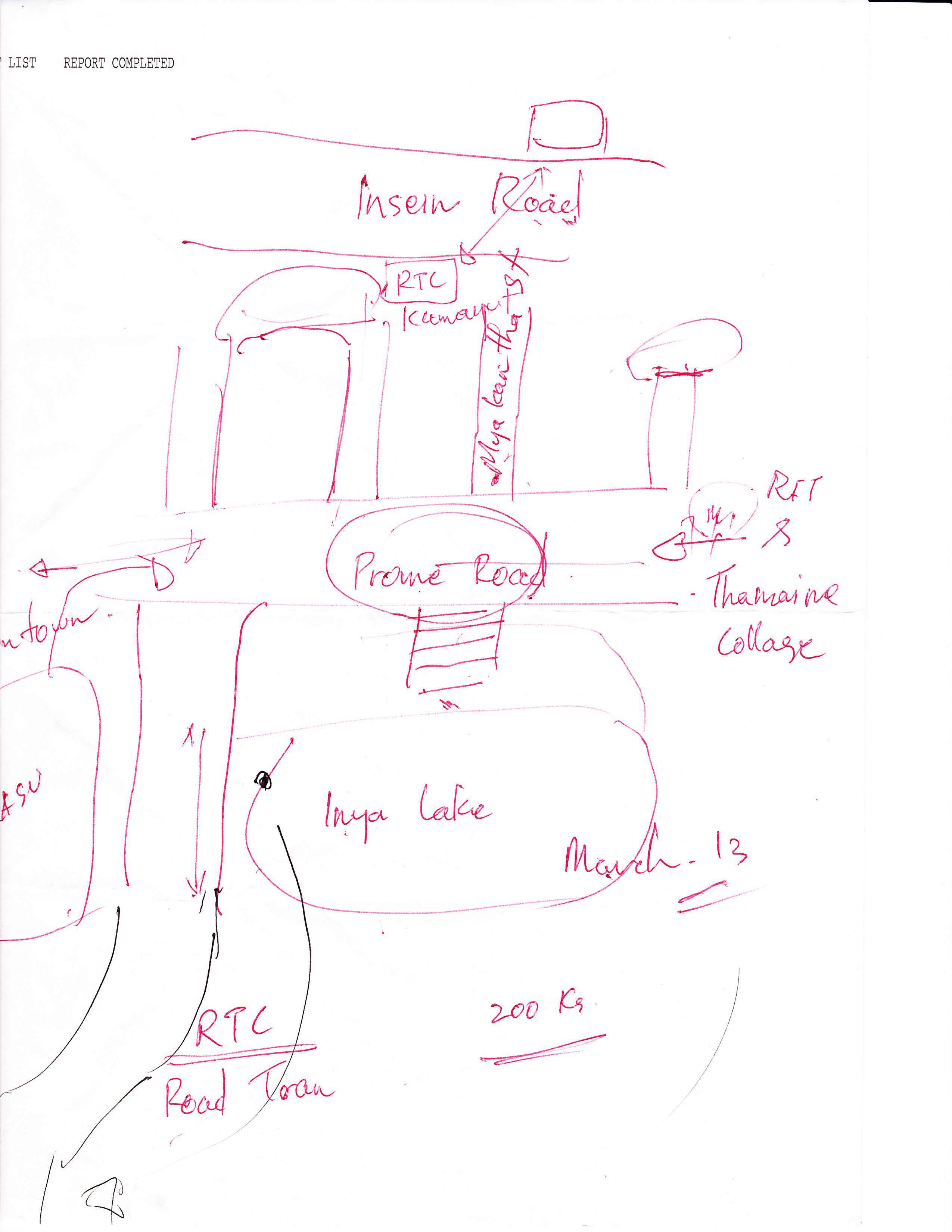Map of a Shooting Gallery: Protestors of March 1988
by Elizabeth Hoover / July 15, 2010 / 1 Comment
In explaining the horrors he experienced in Burma, words are not always enough for Than What. This is a map he drew to show how the Burmese military turned Prome Road into a shooting gallery on March 13th, 1988, gunning down students who had gathered to protest the economic policies of the government.
In September 1987, General Ne Win, then ruler of Burma, canceled certain denominations of the kyat, the country’s currency. A practitioner of numerology, he only wanted bills in circulation with denominations divisible by 9 because his astrologer told him that was his lucky number.
As a result, thousands of people lost their savings and many students were left penniless. Students from Rangoon Institute of Technology (now Yangon Technological Institute) and Thamaine College decided to join together in protests. They poured down Prome Road, unwittingly trapping themselves between Inya Lake and a series of dead-end streets.
Than What, who asked that his name be changed because he still has family in Burma, was working at Rangoon Institute of Technology and joined the students in their protests. He said he watched helplessly as the military surrounded the students and sprayed bullets into the crowd.
“One of my friends die in front of me,” he said. “We can’t do anything but run. We abandoned him.”
Than What was able to flee down a side street and into a building, but others were not so lucky. On the above map, he drew stairs leading down to Inya Lake and said protesters tried to escape down the stairs. “We call these the Red Stairs because a lot of people died on them,” he said. “There is a lot of blood on these stairs.”
Later he heard that the soldiers raped some of the female protestors.
After the protest, the survivors were afraid to talk about what happened. “We can’t talk in front of the other people,” he said. “Everybody was hopeful before the march, but not now.”
But Than What didn’t give up trying to tell the story of his friends who were killed, arrested, and injured in the protest. In mid-May a publication called 48 Pages started circulating surreptitiously in Burma. The publication told the history of the student protest movement back to 1960 and included testimonials from the March.
People were desperate to get their hands on it, so Than What, who owned a carbon copier, made about 50 copies and distributed them. He also worked with some other activists to publish a magazine. His political activity was hampered by family and financial obligations, but he continued to help copy and distribute unofficial newspapers until he was forced to flee Burma in 2002, leaving behind is wife and his 2-year-old son.
He has since resettled in Pittsburgh. He works at Breadworks, a bakery on the Northside, and lives in Troy Hill, where he bought a house. He said he likes living in Pittsburgh and his favorite place is the overlook at Mount Washington, where he goes to try to forget about all he has experienced. He said, “It’s my mind’s exit place.”
But he can never fully escape what he saw on Prome Road in 1988. “When I sleep, I dream about it. I never forget it,” he said.
Read how Than What came to Pittsburgh here.
Than What’s story is just one of many we will cover in greater detail in our upcoming special issue on Burma. Click here to join our mailing list and receive a notice when the Burma issue is published.
Read Elizabeth’s bio.






One Comment on "Map of a Shooting Gallery: Protestors of March 1988"
I am awed and humbled by Than What’s bravery and dedication to sharing accounts from Burma. And I am deeply saddened by these accounts.